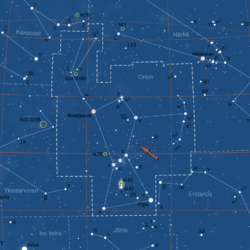25 Orionis
| Observation data Epoch J2000 Equinox J2000 | |
|---|---|
| Constellation | Orion |
| Right ascension | 05h 24m 44.8265s[1] |
| Declination | 01° 50′ 47.201″[1] |
| Apparent magnitude (V) | 4.873 |
| Characteristics | |
| Spectral type | B1Vpe[1] |
| U−B color index | -0.92[2] |
| B−V color index | -0.20[2] |
| Astrometry | |
| Radial velocity (Rv) | 19.3[1] km/s |
| Proper motion (μ) | RA: 0.12[1] mas/yr Dec.: -0.60[1] mas/yr |
| Parallax (π) | 2.94 ± 0.87[3] mas |
| Distance | approx. 1,100 ly (approx. 300 pc) |
| Details | |
| Mass | 10.5[4] M☉ |
| Radius | 6.4[5] R☉ |
| Luminosity | 10,500[4] L☉ |
| Surface gravity (log g) | 4.0[5] cgs |
| Temperature | 24,661 ± 339[5] K |
| Rotational velocity (v sin i) | 316[6] km/s |
| Age | ~100[4] Myr |
| Other designations | |
| Database references | |
| SIMBAD | data |
25 Orionis, less commonly known by its Bayer designation Psi1 Orionis (Ψ1 Orionis, Ψ1 Ori) is a fifth-magnitude star in the constellation Orion. Its kinematics place it among a dense cluster of almost 200 low-mass pre-main-sequence stars in the Orion OB1a subassociation known as the 25 Orionis group.[7]
Properties
Like the star Pleione in the Pleiades open cluster, 25 Ori is a Be star with a gaseous circumstellar disk. The SIMBAD astronomical database lists its spectral class as B1Vpe.[1] The suffix "pe" refers to "Emission lines with peculiarity", a classification typical of many Be stars whose peculiar emissions come from the gaseous equatorial disks formed of material ejected from the star.
25 Orionis is a fast rotator, clocking a rotational velocity of 316 km/s, significantly faster than Achernar's speed of 251 km/s in the constellation Eridanus.[6][8] Having a radius of 6 R☉, the star rotates on its axis roughly once every 23 hours. With a mass in excess of 10 M☉, the star is expected to explode as a supernova.[4]
See also
- Lists of stars in the constellation Orion
- Class B Stars
- Be stars
- Shell star
- Circumstellar disk
References
- 1 2 3 4 5 6 7 "SIMBAD query result:* 25 Ori -- Be Star". Centre de Données astronomiques de Strasbourg. Retrieved 2010-11-07.
- 1 2 Johnson, H. L.; et al. (1966). "UBVRIJKL photometry of the bright stars" (PDF). Communications of the Lunar and Planetary Laboratory. 4 (Part 1): 99–110. Bibcode:1966CoLPL...4...99J.
- ↑ Perryman, M. A. C.; et al. (1997), "The Hipparcos Catalogue", Astronomy & Astrophysics, 323: L49–L52, Bibcode:1997A&A...323L..49P
- 1 2 3 4 Kaler, James B., "25 ORI (25 Orionis)", Stars, University of Illinois, retrieved 2010-11-07
- 1 2 3 Underhill, A. B.; et al. (November 1979), "Effective temperatures, angular diameters, distances and linear radii for 160 O and B stars", Monthly Notices of the Royal Astronomical Society, 189: 601–605, Bibcode:1979MNRAS.189..601U, doi:10.1093/mnras/189.3.601
- 1 2 "Bright Star Catalogue (Hoffleit+, 1991)", VizieR (5th Revised ed.), Centre de Données astronomiques de Strasbourg, retrieved 2010-11-07
- ↑ Briceño, César; et al. (June 2007). "25 Orionis: A Kinematically Distinct 10 Myr Old Group in Orion OB1a" (PDF). The Astronomical Journal. 661 (2): 1119–1128. arXiv:astro-ph/0701710
 . Bibcode:2007ApJ...661.1119B. doi:10.1086/513087. Retrieved 2010-11-07.
. Bibcode:2007ApJ...661.1119B. doi:10.1086/513087. Retrieved 2010-11-07. - ↑ "Bright Star Catalogue (Hoffleit+, 1991)". VizieR (5th Revised ed.). Centre de Données astronomiques de Strasbourg. Retrieved 2010-11-08.
External links
- Jim Kaler's Stars, University of Illinois: 25 ORI (25 Orionis)
- Philippe Stee's in-depth information on: Hot and Active Stars Research
- Olivier Thizy's in-depth information on: Be Stars
Coordinates: ![]() 05h 24m 44.80s, +01° 50′ 47.0″
05h 24m 44.80s, +01° 50′ 47.0″
